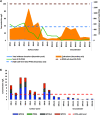Occurrence, Fate, and Related Health Risks of PFAS in Raw and Produced Drinking Water
- PMID: 36779784
- PMCID: PMC9979608
- DOI: 10.1021/acs.est.2c06015
Occurrence, Fate, and Related Health Risks of PFAS in Raw and Produced Drinking Water
Abstract
This study investigates human exposure to per- and polyfluoroalkyl substances (PFAS) via drinking water and evaluates human health risks. An analytical method for 56 target PFAS, including ultrashort-chain (C2-C3) and branched isomers, was developed. The limit of detection (LOD) ranged from 0.009 to 0.1 ng/L, except for trifluoroacetic-acid and perfluoropropanoic-acid with higher LODs of 35 and 0.24 ng/L, respectively. The method was applied to raw and produced drinking water from 18 Dutch locations, including groundwater or surface water as source, and applied various treatment processes. Ultrashort-chain (300 to 1100 ng/L) followed by the group of perfluoroalkyl-carboxylic-acids (PFCA, ≥C4) (0.4 to 95.1 ng/L) were dominant. PFCA and perfluoroalkyl-sulfonic-acid (≥C4), including precursors, showed significantly higher levels in drinking water produced from surface water. However, no significant difference was found for ultrashort PFAS, indicating the need for groundwater protection. Negative removal of PFAS occasionally observed for advanced treatment indicates desorption and/or degradation of precursors. The proportion of branched isomers was higher in raw and produced drinking water as compared to industrial production. Drinking water produced from surface water, except for a few locations, exceed non-binding provisional guideline values proposed; however, all produced drinking waters met the recent soon-to-be binding drinking-water-directive requirements.
Keywords: PFAS; PFAS isomers; drinking water; exposure assessment; water quality.
Conflict of interest statement
The authors declare no competing financial interest.
Figures





Similar articles
-
Concentrations and patterns of perfluoroalkyl and polyfluoroalkyl substances in a river and three drinking water treatment plants near and far from a major production source.Sci Total Environ. 2017 Apr 1;583:393-400. doi: 10.1016/j.scitotenv.2017.01.079. Epub 2017 Jan 20. Sci Total Environ. 2017. PMID: 28117151
-
Target and nontarget screening of PFAS in drinking water for a large-scale survey of urban and rural communities in Québec, Canada.Water Res. 2023 Apr 15;233:119750. doi: 10.1016/j.watres.2023.119750. Epub 2023 Feb 16. Water Res. 2023. PMID: 36827766
-
Perfluoroalkyl substances (PFAS) in river and ground/drinking water of the Ganges River basin: Emissions and implications for human exposure.Environ Pollut. 2016 Jan;208(Pt B):704-13. doi: 10.1016/j.envpol.2015.10.050. Environ Pollut. 2016. PMID: 26561452
-
Per- and polyfluoroalkyl substances in water and wastewater: A critical review of their global occurrence and distribution.Sci Total Environ. 2022 Feb 25;809:151003. doi: 10.1016/j.scitotenv.2021.151003. Epub 2021 Oct 22. Sci Total Environ. 2022. PMID: 34695467 Free PMC article. Review.
-
Global occurrence and probabilistic environmental health hazard assessment of per- and polyfluoroalkyl substances (PFASs) in groundwater and surface waters.Sci Total Environ. 2022 Apr 10;816:151535. doi: 10.1016/j.scitotenv.2021.151535. Epub 2021 Nov 9. Sci Total Environ. 2022. PMID: 34762945 Review.
Cited by
-
Sorption of per- and poly-fluoroalkyl substances and their precursors on activated carbon under realistic drinking water conditions: Insights into sorbent variability and PFAS structural effects.Heliyon. 2024 Jan 26;10(3):e25130. doi: 10.1016/j.heliyon.2024.e25130. eCollection 2024 Feb 15. Heliyon. 2024. PMID: 38317999 Free PMC article.
-
A stochastic approach for parameter optimization of feature detection algorithms for non-target screening in mass spectrometry.Anal Bioanal Chem. 2024 Jul 12. doi: 10.1007/s00216-024-05425-3. Online ahead of print. Anal Bioanal Chem. 2024. PMID: 38995405
-
Emergency of per- and polyfluoroalkyl substances in drinking water: Status, regulation, and mitigation strategies in developing countries.Eco Environ Health. 2024 Jun 26;3(3):355-368. doi: 10.1016/j.eehl.2024.05.008. eCollection 2024 Sep. Eco Environ Health. 2024. PMID: 39281067 Free PMC article. Review.
-
There's Something in What We Eat: An Overview on the Extraction Techniques and Chromatographic Analysis for PFAS Identification in Agri-Food Products.Foods. 2024 Apr 1;13(7):1085. doi: 10.3390/foods13071085. Foods. 2024. PMID: 38611389 Free PMC article. Review.
-
Finding non-fluorinated alternatives to fluorinated gases used as refrigerants.Environ Sci Process Impacts. 2024 Nov 13;26(11):1955-1974. doi: 10.1039/d4em00444b. Environ Sci Process Impacts. 2024. PMID: 39360734 Free PMC article. Review.
References
-
- UN OWG . Introduction to the Proposal of the Open Working Group for the Sustainable Development Goals. Outcome Document as of 19 6, 2014 (Online), 2014.
-
- Ankley G. T.; Cureton P.; Hoke R. A.; Houde M.; Kumar A.; Kurias J.; Lanno R.; McCarthy C.; Newsted J.; Salice C. J.; Sample B. E.; Sepúlveda M. S.; Steevens J.; Valsecchi S. Assessing the Ecological Risks of Per- and Polyfluoroalkyl Substances: Current State-of-the Science and a Proposed Path Forward. Environ. Toxicol. Chem. 2021, 40, 564–605. 10.1002/etc.4869. - DOI - PMC - PubMed
-
- Fenton S. E.; Ducatman A.; Boobis A.; DeWitt J. C.; Lau C.; Ng C.; Smith J. S.; Roberts S. M. Per- and Polyfluoroalkyl Substance Toxicity and Human Health Review: Current State of Knowledge and Strategies for Informing Future Research. Environ. Toxicol. Chem. 2021, 40, 606–630. 10.1002/etc.4890. - DOI - PMC - PubMed
-
- OECD . Summary Report on the New Comprehensive Global Database of Per- and Polyfluoroalkyl Substances (PFASs), 2018.
Publication types
MeSH terms
Substances
LinkOut - more resources
Full Text Sources
Medical
Research Materials
Miscellaneous

